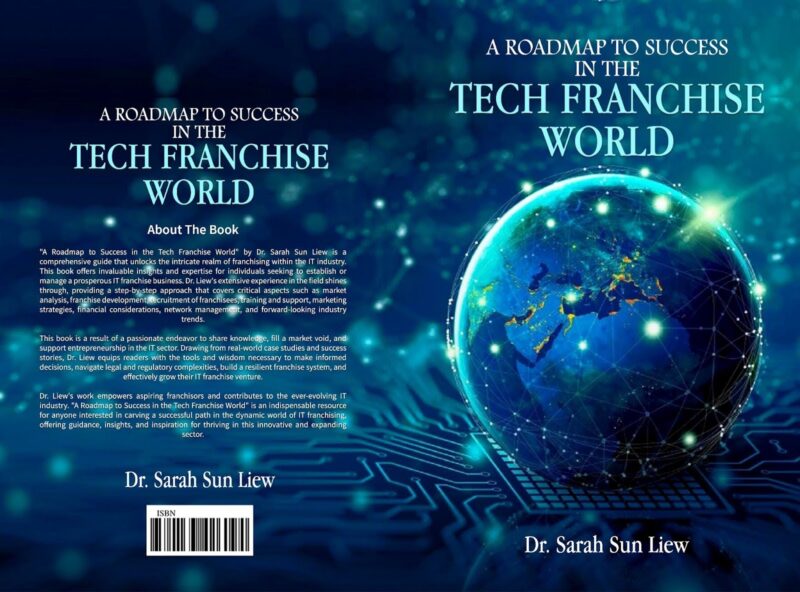By: Meridian Beverly Hills Investment and Legal Group Inc
Introduction: The Power of a Long-Term Vision
Chapter 12, titled “Developing a Long-Term Vision for Your Franchise,” is a critical and inspiring chapter in Dr. Sarah Sun Liew’s book, “A Roadmap to Success in the Tech Franchise World.” This chapter emphasizes the importance of creating a long-term vision that guides both the franchisor and franchisees in achieving sustainable growth, innovation, and resilience in a rapidly evolving market.

Dr. Liew argues that having a clear and compelling vision is essential for setting strategic direction, aligning goals, and motivating all stakeholders involved in the franchise network. For tech franchisees, developing a long-term vision is particularly crucial due to the industry’s fast-paced nature, where technological advancements, market trends, and consumer preferences are in constant flux. This chapter provides practical guidance on how to define, communicate, and implement a long-term vision that drives success and keeps the franchise aligned with its core values and objectives.
Why a Long-Term Vision is Crucial for Franchise Success
The chapter begins by explaining why a long-term vision is vital for franchise success. Dr. Liew emphasizes that a long-term vision serves as a roadmap that outlines where the franchise aims to go and how it plans to get there. It provides a sense of purpose and direction, helping franchisees stay focused on their goals and make decisions that align with their overall strategy.
Several key benefits of having a long-term vision are discussed:
- Strategic Clarity: A well-defined vision provides strategic clarity, helping franchisees understand their priorities and allocate resources effectively. Dr. Liew explains that a clear vision allows franchisees to set realistic goals, measure progress, and stay on track to achieve their objectives.
- Motivation and Engagement: A compelling vision inspires and motivates franchisees, employees, and other stakeholders to work toward a common goal. Dr. Liew notes that a shared vision fosters a sense of ownership, commitment, and passion, which is crucial for overcoming challenges and maintaining momentum.
- Resilience and Adaptability: In the face of market uncertainties and technological disruptions, a strong vision provides a stable foundation that helps franchisees remain resilient and adaptable. Dr. Liew argues that a clear vision enables franchisees to anticipate changes, pivot when necessary, and stay focused on their long-term objectives.
- Brand Consistency: A unified vision helps maintain brand consistency across all franchise locations. Dr. Liew emphasizes that a consistent brand image is essential for building trust, loyalty, and recognition among customers. A shared vision ensures that all franchisees adhere to the brand’s values, standards, and promises.
- Sustainable Growth: A long-term vision guides sustainable growth by aligning short-term actions with long-term goals. Dr. Liew points out that a strategic vision helps franchisees make informed decisions, avoid short-sighted thinking, and invest in initiatives that drive long-term success.

Defining Your Long-Term Vision: Key Considerations
Chapter 12 provides a step-by-step approach to defining a long-term vision for a tech franchise. Dr. Liew emphasizes that a vision should be ambitious yet realistic, forward-looking yet grounded in the present, and broad enough to encompass future opportunities yet specific enough to provide direction.
To define a long-term vision, Dr. Liew suggests considering the following key factors:
- Core Values and Mission: A strong vision is rooted in the core values and mission of the franchise. Dr. Liew advises franchisees to reflect on what the franchise stands for, what it aims to achieve, and what makes it unique. The vision should align with the brand’s mission and reflect its commitment to delivering value to customers, employees, and the community.
- Market Trends and Opportunities: A forward-looking vision should take into account emerging market trends, technological advancements, and potential growth opportunities. Dr. Liew encourages franchisees to conduct market research, analyze industry dynamics, and identify areas where the franchise can innovate, differentiate itself, and capture new opportunities.
- Competitive Landscape: Understanding the competitive landscape is essential for defining a vision that sets the franchise apart. Dr. Liew recommends analyzing competitors’ strengths and weaknesses, assessing market gaps, and identifying the franchise’s unique selling proposition (USP). The vision should articulate how the franchise plans to differentiate itself and create a competitive advantage.
- Customer Needs and Preferences: A customer-centric vision focuses on meeting and exceeding customer expectations. Dr. Liew emphasizes that franchisees should consider the evolving needs, preferences, and behaviors of their target audience when defining their vision. The vision should reflect a commitment to delivering exceptional customer experiences and fostering long-term loyalty.
- Sustainability and Social Responsibility: In today’s business environment, sustainability and social responsibility are increasingly important considerations. Dr. Liew suggests that franchisees incorporate these elements into their vision, demonstrating their commitment to ethical practices, environmental stewardship, and positive social impact.
Communicating and Aligning Your Vision
Once a long-term vision is defined, Dr. Liew explains that it is crucial to communicate it effectively to all stakeholders, including franchisees, employees, customers, and partners. Clear and consistent communication ensures that everyone understands, believes in, and is motivated to work toward the vision.
Dr. Liew provides several strategies for communicating and aligning the vision:
- Use Clear and Compelling Language: The vision should be articulated in clear, simple, and compelling language that resonates with all stakeholders. Dr. Liew advises avoiding jargon and technical terms, instead using language that is relatable and inspiring. The vision statement should be memorable and easy to understand.
- Incorporate the Vision into All Aspects of the Business: To ensure alignment, the vision should be integrated into all aspects of the franchise, from marketing and branding to operations and customer service. Dr. Liew suggests that franchisees use the vision as a guiding principle for decision-making, goal-setting, and strategy development.
- Engage and Involve Stakeholders: Dr. Liew emphasizes the importance of engaging and involving all stakeholders in the vision-setting process. Franchisees should seek input from employees, customers, and partners, and encourage open dialogue and feedback. This fosters a sense of ownership and commitment to the vision.
- Lead by Example: Franchise leaders must lead by example, demonstrating their commitment to the vision through their actions, decisions, and behavior. Dr. Liew advises franchisors and franchisees to embody the values and principles of the vision in everything they do, setting a positive example for others to follow.
- Regularly Review and Reinforce the Vision: The vision should be reviewed and reinforced regularly to ensure that it remains relevant and aligned with the franchise’s goals. Dr. Liew suggests conducting regular vision check-ins, sharing progress updates, celebrating achievements, and making adjustments as needed.
Implementing a Long-Term Vision: Strategies for Success
Chapter 12 also provides practical strategies for implementing a long-term vision and turning it into reality. Dr. Liew emphasizes that a vision is only effective if it is translated into actionable plans and measurable objectives. She outlines several key strategies for successful implementation:
- Set SMART Goals: Dr. Liew recommends setting SMART (Specific, Measurable, Achievable, Relevant, and Time-bound) goals that align with the long-term vision. These goals should be broken down into actionable steps, with clear timelines and responsibilities assigned to specific individuals or teams. Regular progress monitoring and evaluation are essential to stay on track.
- Develop a Strategic Plan: A strategic plan outlines the roadmap for achieving the long-term vision. Dr. Liew suggests that franchisees create a detailed plan that includes market analysis, competitive positioning, target audience, marketing strategies, operational processes, financial projections, and key performance indicators (KPIs). The plan should be reviewed and updated regularly to reflect changing market conditions.
- Foster a Culture of Innovation: A long-term vision requires a culture of innovation that encourages creativity, experimentation, and continuous improvement. Dr. Liew advises franchisees to foster an environment where employees feel empowered to share ideas, take risks, and challenge the status quo. Regular brainstorming sessions, innovation workshops, and cross-functional collaboration can help drive innovation.
- Leverage Technology: Technology plays a crucial role in implementing a long-term vision, particularly in the tech industry. Dr. Liew recommends leveraging technology tools and platforms to enhance operational efficiency, improve customer experiences, and drive growth. Franchisees should invest in data analytics, digital marketing, automation, and other technologies that support their vision.
- Build Strong Partnerships: Strategic partnerships can help accelerate the implementation of a long-term vision by providing access to new markets, resources, and expertise. Dr. Liew encourages franchisees to build strong relationships with suppliers, vendors, industry associations, and other stakeholders who can support their growth objectives.
- Monitor Progress and Adjust as Needed: Regular monitoring and evaluation are essential to ensure that the franchise is on track to achieve its vision. Dr. Liew advises franchisees to use KPIs and performance metrics to measure progress, identify areas for improvement, and make adjustments as needed. Flexibility and adaptability are key to responding to changing market conditions and new opportunities.
Case Studies: Franchise Success Stories Driven by a Strong Vision
Chapter 12 includes several case studies of successful tech franchises that have developed and implemented strong long-term visions. These case studies illustrate how a clear vision can drive growth, innovation, and resilience in the face of challenges.
- Case Study: Vision-Driven Innovation: One case study features a tech franchise that developed a vision to become a leader in sustainable technology solutions. By focusing on eco-friendly products, energy-efficient services, and social responsibility, the franchise was able to differentiate itself in the market, attract environmentally conscious customers, and achieve significant growth.
- Case Study: Navigating Market Disruptions: Another case study discusses a tech franchise that faced significant market disruptions due to rapid technological advancements. By staying true to its vision of delivering cutting-edge solutions, the franchise embraced new technologies, pivoted its business model, and successfully navigated the challenges, emerging as a market leader.
- Case Study: Building a Customer-Centric Culture: A third case study showcases a tech franchise that developed a vision centered around delivering exceptional customer experiences. By investing in employee training, digital tools, and personalized services, the franchise built a loyal customer base and achieved strong financial performance.
Conclusion: The Key to Potentially Sustained Success
Chapter 12 of “A Roadmap to Success in the Tech Franchise World” provides a comprehensive guide to developing and implementing a long-term vision for a tech franchise. Dr. Liew emphasizes that a clear, compelling vision is essential for setting strategic direction, aligning goals, and driving sustainable growth in a competitive market.
By defining a vision that reflects the franchise’s core values, market opportunities, and customer needs, and by implementing it through actionable plans and measurable objectives, franchisees can build a thriving and resilient business that stands the test of time. This chapter serves as a valuable resource for readers, offering practical strategies and insights to help them create a vision that inspires, motivates, and delivers lasting success.
Published by: Nelly Chavez






